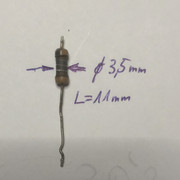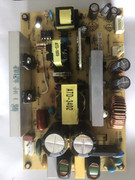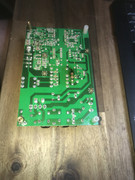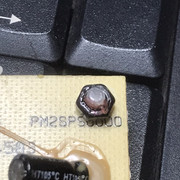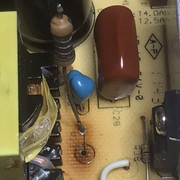|
|
Post by serafis on Nov 25, 2016 21:24:38 GMT -5
Hi, I picked up an Onkyo TX-NR579 dirt cheap, with a fault that when powered on, the display would light up but then it would power straight off again 2 seconds later. After some investigation (I'm an amateur rather than an expert), I found that the HDMI board was not delivering / getting its 5.2V supply. Following the schematic in the service manual, I tracked down the 5.2V regulator section on the HDMI board and found that three SMD components were physically damaged or missing completely - these were L8961 (choke), C8962 (104K) and C8963 (106K), filter components on the 12V input to the regulator circuit. At some stage the electrolytics had been replaced too (rather clumsily), and I don't know whether the damage was caused then, or whether it was maybe electrical overload, or both.
Anyway, I replaced the two capacitors with standard caps (I don't have SMD's available), and just put a link in place of the choke as I didn't have anything suitable for this. After doing this, the receiver now powers up and stays on and all its functions work, including audio, DSP, network and HDMI input switching. Actually sounds pretty good.
But there's no HDMI output. And when I measure voltages on the HDMI port, this is what I get:
D2+ = 3.3
V
D2 Shield = 0V
D2- = 3.3
V
D1+= 3.3V
D1 Shield = 0V
D1- = 3.3
V
D0+ = 3.3
V
D0 Shield = 0V
D0- = 3.3
V
CLK+ = 0.1V
CLK Shield = 0V
CLK- = 0.76
V
CER Remote = 3.2
V
HEAC+ = 0.1
V
DDC Clock = 5
V
DDC Data = 5V
GND = 0V
5V = 5V
HPD/HEAC = 0.1
V
Do you think there is any chance of repairing this, or do you think the HDMI output chip (or the board) is fried?
Any help gratefully appreciated.
|
|
|
|
Post by mastertech on Nov 25, 2016 22:10:02 GMT -5
Does HDMI input sound work?
|
|
|
|
Post by serafis on Nov 25, 2016 22:59:52 GMT -5
Yes, HDMI inputs all work for sound, Network Radio and USB both work, and all DSP and speaker configuration functions work. The DTS chip is marked 'New'. It's only HDMI output that doesn't work, other than that it's completely functional now.
|
|
|
|
Post by mastertech on Nov 26, 2016 12:33:00 GMT -5
Unfortunately because of the complexity of the video system there is not a direct troubleshooting solution. About all you can do is test all the voltage regulators for proper voltage in all areas of the video system, not just the HDMI system. Scan over the schematics of the various parts that pertain to video and locate any regulators that pertain to those ic's and such and test them for proper output. It may surprise you of what you find.
The only suggestion I have to start with is that I am curious why there is no voltage on the CK+ and CK- pins of the HDMI out connector. I don't know for sure what voltage should be there if any but I see the HDMI input connectors have the same pins and since they are working I would test those 2 lines on an input connector to see if there is any voltage there.
|
|
|
|
Post by mastertech on Nov 26, 2016 18:59:27 GMT -5
Try this test. Unplug the receiver. Set your DMM to diode scale and test between DO-,DO+,D1-,D1+,D2-,D2+. See what kind of readings you get.
|
|
|
|
Post by serafis on Nov 28, 2016 21:24:19 GMT -5
Thanks for the reply. Found a dry electrolytic capacitor joint on the video processor board and resoldered that, but unfortunately no difference. Then I did as you suggested and used the DMM on diode between the pins. I also measured the same on an Onkyo TX-SR313 and an Android TV box, both with working HDMI outputs, by way of comparison. The DMM diode test results are as follows (note, with nothing connected, DMM displays '1', which I refer to as 'no reading'): From
(DMM red lead) | To
(DMM black lead) | TX-NR579 | TX-SR313 | Android Box | | D2+ | D2 shield | No reading | No Reading | No reading | | D2 shield | D2+ | ~1046 | ~853 | ~1133 | | D2- | D2 shield | No reading | No reading | No reading | | D2 shield | D2- | ~1046 | ~855 | ~1130 | | D2+ | D2- | ~1963 | No reading | ~1381 | | D2- | D2+ | ~1963 | No reading | ~1381 |
|
|
|
|
| | D1+ | D1 shield | No reading | No reading
| No reading
| | D1 shield | D1+ | ~1067 | ~860 | ~1130 | | D1- | D1 shield | No reading
| No reading
| No reading
| | D1 shield | D1- | ~1067 | ~860 | ~1130 | | D1+ | D1- | Flickers
19nn then
no reading | No reading
| ~1380 | | D1- | D1+ | Flickers
19nn then
no reading
| No reading
| ~1380 |
|
|
|
|
| | D0+ | D0 shield | No reading
| No reading
| No reading
| | D0 shield | D0+ | ~1074 | ~860 | ~1130 | | D0- | D0 shield | No reading
| No reading
| No reading
| | Do shield | D0- | ~1074 | ~860 | ~1130 | | D0+ | D0- | Flickers
19nn then
no reading
| No reading
| ~1381 | | D0- | D0+ | Flickers
19nn then
no reading
| No reading
| ~1380 |
Then I compared the HDMI voltages with the HDMI output on the working Onkyo TX-SR313 and the Android TV box, for comparison. | Pin | Desc | TX-NR579 | TX-NR313 | Android TV | | 1 | DD2+
| 3.28V | ~30mV | ~30mV | | 2 | DD2 shield | 0V | 0V | 0V | | 3 | DD2- | 3.28V | ~30mV | ~30mV | | 4 | DD1+ | 3.28V | ~30mV | ~30mV | | 5 | DD1 shield | 0V | 0V | | 6 | DD1- | 3.28V | ~30mV | ~30mV | | 7 | DD0+ | 3.28V | ~30mV | ~30mV | | 8 | DD0 shield | 0V | 0V | 0V | | 9 | DD0- | 3.28V | ~30mV | ~30mV | | 10 | CLK+ | 0V | ~3mV | ~3mV | | 11 | CLK shield | 0V | 0V | 0V | | 12 | CLK- | 0.76V | ~2mV | ~30mV | | 13 | CEC | 3.18V | 3.17V | 3V | | 14 | Reserved | 0V | 0V | 0V | | 15 | DDC CLK | 4.9V | 4.95V | 5V | | 16 | DDC DATA | 4.9V | 4.95V | 5V | | 17 | GND | 0V | 0V | 0V | | 18 | +5V | 4.96V | 4.97V | 5V | | 19 | Hotplug Detect | 0V | 0V | 0V |
I'm not sure what this tells us, other than that the diode test gave similar results on all three devices (i.e. conducting one way, not the other) but the voltages on the data pins for the TX-NR579 are 100 times greater than the other two devices (~3.3V compared with ~30mV), and the clock pin voltages may be suspect too, although that's hard to tell. Next step is to check the regulators, although that will be difficult given that some of them are on the back of the board so inaccessible when mounted and powered. I've already checked the main HDMI 3.3V and 5.2V supply sections and they seem within reasonable tolerance (output voltages are ~3.28V and ~5.06V, maybe a little low?) I guess I could use an external HDMI switch and splitter, and just use one HDMI input on the receiver like this.... ------------------> TV HDMI devices ---> HDMI switch -----> HDMI Splitter | ------------------> Receiver .... with other A/V devices connected Audio to the receiver and Video to the TV, and just use the receiver for audio. But that's clumsy and I'd rather get the HDMI output working if possible. So any other ideas most appreciated. |
|
|
|
Post by serafis on Nov 29, 2016 23:13:46 GMT -5
I've measured the voltages at all of the regulators I can get at while the unit is switched on, and they all seem to be doing what they should. In particular, the 12V, 5.2V, 5V, 3.3V, 1.8V, 1.5V and 1.0V voltage points on the video and HDMI board (that I could reach / measure) are all within 5% of where they should be. All analog and HDMI audio, switching, Network, USB and and DSP functions work perfectly, as does the auto setup function, Audyssey EQ etc. Component and composite video in/out also works fine. it's just HDMI output that gives 'No Signal". The receiver is in perfect working order apart from the lack of HDMI output. The HDMI output chip gets quite warm too. HDMI 'hotplug' also seem to be working, as when in 'TV Speaker' test mode, even though there's no sound thru the TV speaker, if I unplug the HDMI cable it immediately reverts to 'Amp Speaker' mode. So it might be that there's just no HDMI output data+/- lines(only a 3.3V voltage), and the CLK +/- lines might be suspect, the other signals are maybe OK. I think I've probably reached the limits of my knowledge on this now.  |
|
|
|
Post by mastertech on Dec 1, 2016 13:23:38 GMT -5
Yeah, it probably is a bad ic. Sometimes when they blow on the output, the data lines short together but yours appear not to be shorted. Of course yours is not a regular HDMI transmitter chip like most other AVR's. So hard to say which chip might be bad.
Have you tried HDMI passthrough with the AVR in standby? Does sound even go through on passthrough?
|
|
|
|
Post by serafis on Dec 1, 2016 13:38:24 GMT -5
Yes, I did try that, still 'no signal' and because the handshaking isn't working, no sound either. Wondering whether it's worth trying a reflow on the chip as a last resort, or is that likely to stop other HDMI functions working?
|
|




